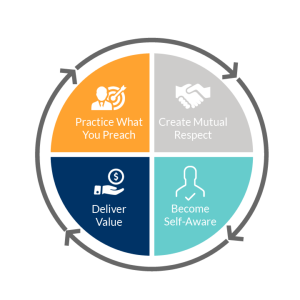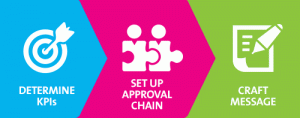— June 13, 2018

Shutterstock
Many of our partners start a mobile app company without any prior experience in sales. Our program trains you to sell apps to small businesses with an online course and hands-on training. While our Mobile Marketing Advisors help you create an actual sales presentation before you go out to a small business, you will need to work on how you deliver that sales pitch. Small businesses are a unique audience in that the owners usually handle almost every aspect of the business – with marketing often left in the dust. Unlike big brands, they might not see any value in mobile marketing just yet. But that’s where you come in!
Here are 7 steps for giving a convincing sales pitch to SMBs:
1. Focus on how you deliver it
While we help you craft the content of your pitch, it is also important to spend time on how you deliver that message. Your body language and tone of voice need to communicate confidence and enthusiasm. Even without your powerful phrases and convincing visuals, you need to show that you believe what you are saying and enjoy talking about it.
And this doesn’t only apply to face-to-face pitches. You can actually hear when someone smiles over the phone! Good posture and natural gestures will make you sound more confident to the person on the other end of the line.
It might sound like an awkward thing to do, but practice in front of the mirror or record yourself giving the pitch. This will help you assess how you come across to others and make improvements where needed. Remember all the things you learned in your public speaking classes? Those things are still relevant.
2. Show empathy
It is said that the secret to success in sales is empathy. You need to be able to put yourself in your (potential) customers’ shoes. Do you understand the challenges they face on a day-to-day basis? The only way you can do this is by asking questions. More specifically, asking the right questions. And then listening to the answers. Ask them about their situation, their work, what they are passionate about etc.
Even though you specialize in small business apps, every industry and every business owner will have different pain points. Of course, there will be overlap, but make sure not to assume that you know their problems. Let them tell you and then offer your solution in response. By understanding where they are coming from, you can provide them with what they need.
3. Talk about solutions, not features
When selling apps, it’s easy to fall into the trap of describing app features rather than benefits. The reality is that small business owners don’t care about the fancy technology behind it; they want to know what’s in it for them. How will it make a difference for them? You can answer this by describing the real-life problems that apps solve! For example, instead of saying you have a cool mobile food ordering feature, you should explain that mobile food ordering will allow them to automate mobile food orders. In addition, their staff will be able to focus on more important things, as they won’t be glued to the phone taking orders. In other words, translate those app features into customer benefits.
4. Turn down low ball offers
Once a small business owner has made the decision to buy from you, they will want to make sure they get the best deal. Their first response is usually that it’s too expensive and they don’t have a budget for your services – and this is often the case. It is up to you to show them the value of the mobile solution and describe how it can save and make them money.
Sometimes – only if it’s necessary – you can offer a client better terms or lower your price. But know your numbers in advance and decide at what point you have to walk away from that low ball price. It won’t do your business any good to take on a client at an extremely low price point, as you will be putting in the same amount of effort as with your regular paying clients.
Barry Moltz, Small Business Expert, says “I believe that all customers will pay more for value to solve their pain. There are many brands, like Apple, in the marketplace that can charge a premium because of perceived value. One way to boost your price is to ask the prospect, “what would the results need to be for you to pay my original price in the proposal?” In this case, you are building value instead of cutting services. In addition, you know what the prospect values and is willing to pay more for.”
5. Ask for the close
This step is often overlooked by novice salespeople: asking for the sale. It might seem presumptuous (and nerve-wracking), but this step is actually all about confidence and practice. Rehearse your close so you can deliver it smoothly. According to Forbes, “It should be a natural progression from your conversation so that asking for purchase is the next logical step.”
Getting the “yes” hinges on more than just the way you ask for the close, of course, but using the right words can definitely make a difference. Hubspot has listed 18 closing phrases to seal a sales deal, take your pick!
6. Anticipate objections
Even if you delivered the most flawless pitch and closing phrase, you will inevitably be dealing with rejection as a salesperson. But not every rejection is final! You will hear many objections that can be refuted and handled in a productive way. This doesn’t mean telling your prospect they’re wrong, it means helping them come to a different conclusion on their own accord.
Small businesses will bring up sales objections about the price (as mentioned); about the competition (e.g. “I can get a cheaper version of your product from someone else”); about the product (e.g. “Apps are just a fad”) and so on. Read about the most common sales objections here.
A well-prepared salesperson will identify all these objections before giving a pitch. Make sure you have a straightforward answer for each of these objections. This will put you in a knowledge position, ready to tackle any (unfounded) objection that gets thrown at you. But remember that rejection is part of the job and that it’s okay if you get a firm “no” – time to move on to the next prospect.
7. Follow up
The actual sales pitch only gets you a foot in the door. Following up is where the magic happens. In fact, 80% of sales deals are made in the follow-up calls after the meeting. Be consistent and relentless. Do everything you can to stay connected with an interested prospect after your initial meeting.
The challenge many salespeople experience is how to effectively follow up without being annoying. Sales Hacker shares an invaluable tip: “Always have a specific reason to contact your prospect. NEVER just call to ‘touch base’ or ‘check in’. Make sure you are calling to add value for the small business owner, maybe that is sharing some new information regarding your product or simply asking them if they need anything in order to make their decision.
With these tips, and our sales training, you will be able to hit the ground running – even if you have never sold anything in your life. With a little preparation, you can position yourself as a small business expert selling a much-needed solution to SMBs.
Business & Finance Articles on Business 2 Community
(85)







